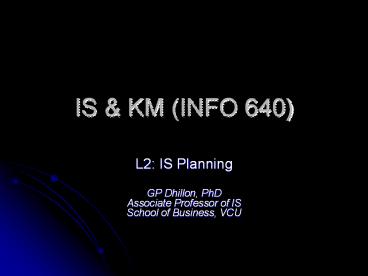IS PowerPoint PPT Presentation
1 / 22
Title: IS
1
IS KM (INFO 640)
- L2 IS Planning
- GP Dhillon, PhD
- Associate Professor of IS
- School of Business, VCU
2
Inputs to IS planning
3
Expanding the portfolio - a
4
Expanding the portfolio - b
5
High potential applicationskey features
6
Strategic applicationskey features
7
Key operational applicationskey features
8
Support applicationskey features
Requirements
9
Application portfolio in different IS/IT
environments
H
Complex
Opportunistic
Application portfolio
Application portfolio
Diffusion (Ability to devolve IS/IT decisions)
Application portfolio
Application portfolio
Traditional
L
Backbone
H
L
Infusion (impact of IS/IT on a business)
10
Key questions in an application portfolio
11
Things to do in an application portfolio
12
Managing the evolution of an application over time
High Potential
Strategic
Lose individual ownership and freedom
Gain senior management support IT involvement
project management
Re-engineer for long term use
Return to standards
Re-evaluate benefits and costs
Fully integrated with other applications for
effectiveness
Evaluate lower cost options to meet core needs
Support
Key Operational
13
Avoiding the disintegration of the portfolio
Individual initiatives
Business initiatives
High Potential
Strategic
Decisions about which to exploit and when
How to resource and manage? How to justify and
reap benefits from business changes? How to
ensure appropriate linkages etc to avoid enormous
rework later?
How to evaluate and select/reject? How to
convert to strategic? Or restrict further risk?
Lack of definition between HP and Support
Provision of resources
How and when to consolidate
How to release resources and ensure existing
systems and infrastructure will support the
strategic applications?
Key Operational
Support
14
Implementing IS Plans
15
Organizational structuresbasic choices
- Centralized Structure
- One line manager directly responsible
- Defined corporate wide procedures and controls
- Data administration under singular control
- Decentralized Structure
- Several individuals work independent of each
other - Each unit may conduct independent analysis and
design - Special purpose d/b and applications at each unity
16
Centralized
17
Decentralized
18
Rationale for choosing particular organizational
structures
- Central coordination of all requirements will
produce better decision making - Technology can create business advantages and
risks are worth taking - Market makes the best decision and users are
responsible for business results - Information is a corporate good and a key
resource for users to employ - Information is a limited resource and its
development must be clearly justified
19
Rationale cont/-
- Central coordination of all requirements will
produce better decision making - Technology can create business advantages and
risks are worth taking - Market makes the best decision and users are
responsible for business results - Information is a corporate good and a key
resource for users to employ - Information is a limited resource and its
development must be clearly justified
Centrally planned
Leading edge
Free market
Monopoly
Scarce resource
20
The rationale takes the form of generic
information systems implementation strategies
21
Generic strategies and the application portfolio
High Potential
Strategic
Leading edge Free market
Centrally planned
Free market Scarce resource
Monopoly
Support
Key Operational
Centralized
Decentralized
22
Resourcing applications
High Potential
Strategic
Support
Key Operational

